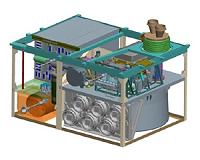 |
Pasadena CA (JPL) Feb 21, 2011 NASA's Mars Science Laboratory rover, Curiosity, will carry a next generation, onboard "chemical element reader" to measure the chemical ingredients in Martian rocks and soil. The instrument is one of 10 that will help the rover in its upcoming mission to determine the past and present habitability of a specific area on the Red Planet. Launch is scheduled between Nov. 25 and Dec. 18, 2011, with landing in August 2012. The Alpha Particle X-Ray Spectrometer (APXS) instrument, designed by physics professor Ralf Gellert of the University of Guelph in Ontario, Canada, uses the power of alpha particles, or helium nuclei, and X-rays to bombard a target, causing the target to give off its own characteristic alpha particles and X-ray radiation. This radiation is "read by" an X-ray detector inside the sensor head, which reveals which elements and how much of each are in the rock or soil. Identifying the elemental composition of lighter elements such as sodium, magnesium or aluminum, as well as heavier elements like iron, nickel or zinc, will help scientists identify the building blocks of the Martian crust. By comparing these findings with those of previous Mars rover findings, scientists can determine if any weathering has taken place since the rock formed ages ago. All NASA Mars rovers have carried a similar instrument - Pathfinder's rover Sojourner, Spirit and Opportunity, and now Curiosity, too. Improvements have been made with each generation, but the basic design of the instrument has remained the same. "APXS was modified for Mars Science Laboratory to be faster so it could make quicker measurements. On the Mars Exploration Rovers [Spirit and Opportunity] it took us five to 10 hours to get information that we will now collect in two to three hours," said Gellert, the instrument's principal investigator. "We hope this will help us to investigate more samples." Another significant change to the next-generation APXS is the cooling system on the X-ray detector chip. The instruments used on Spirit and Opportunity were able to take measurements only at night. But the new cooling system will allow the instrument on Curiosity to take measurements during the day, too. The main electronics portion of the tissue-box-sized instrument lives in the rover's body, while the sensor head, the size of a soft drink can, is mounted on the robotic arm. With the help of Curiosity's remote sensing instruments - the Chemistry and Camera (ChemCam) instrument and the Mastcam - the rover team will decide where to drive Curiosity for a closer look with the instruments, including APXS. Measurements are taken with the APXS by deploying the sensor head to make direct contact with the desired sample. The rover's brush will be used to remove dust from rocks to prepare them for inspection by APXS and by MAHLI, the rover's arm-mounted, close-up camera. Whenever promising samples are found, the rover will then use its drill to extract a few grains and feed them into the rover's analytical instruments, SAM and CheMin, which will then make very detailed mineralogical and other investigations. Scientists will use information from APXS and the other instruments to find the interesting spots and to figure out the present and past environmental conditions that are preserved in the rocks and soils. "The rovers have answered a lot of questions, but they've also opened up new questions," said Gellert. "Curiosity was designed to pick up where Spirit and Opportunity left off."
Share This Article With Planet Earth
Related Links Mars Lab at JPL Mars News and Information at MarsDaily.com Lunar Dreams and more
 Next Mars Rover Will Check For Ingredients Of Life
Next Mars Rover Will Check For Ingredients Of LifePasadena CA (JPL) Jan 19, 2011 Paul Mahaffy, the scientist in charge of the largest instrument on NASA's next Mars rover, watched through glass as clean-room workers installed it into the rover. The specific work planned for this instrument on Mars requires more all-covering protective garb for these specialized workers than was needed for the building of NASA's earlier Mars rovers. The instrument is Sample Analys ... read more |
|
| The content herein, unless otherwise known to be public domain, are Copyright 1995-2010 - SpaceDaily. AFP and UPI Wire Stories are copyright Agence France-Presse and United Press International. ESA Portal Reports are copyright European Space Agency. All NASA sourced material is public domain. Additional copyrights may apply in whole or part to other bona fide parties. Advertising does not imply endorsement,agreement or approval of any opinions, statements or information provided by SpaceDaily on any Web page published or hosted by SpaceDaily. Privacy Statement |